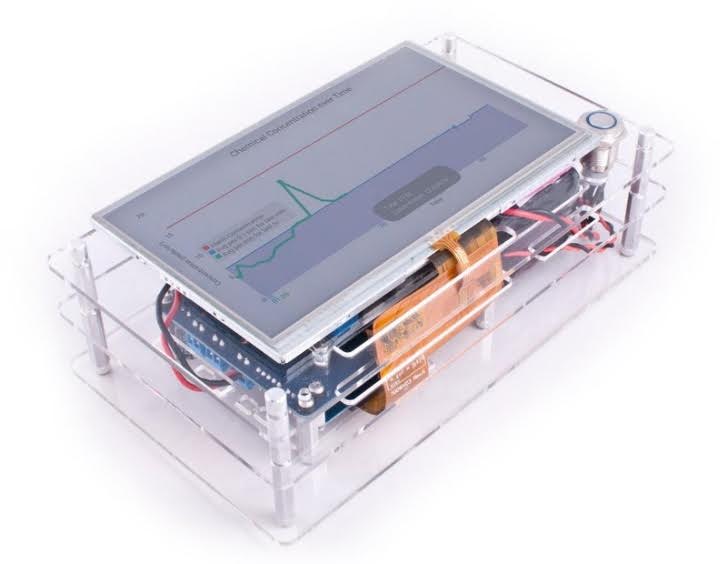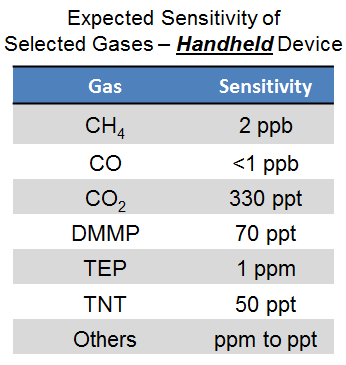
NANOPHOTONICS BREAKTHROUGH TO DRIVE HANDHELD GAS SENSORS
Omega Optics, a leader in nanophotonics R&D, is developing novel technology that will revolutionize the world of “lab-on- chip” (LOC) optical absorption spectroscopy.
Our most recent achievements and innovations in monolithic integration of light sources, detectors and “slow light” photonic transducers enable miniaturization and higher detection sensitivity by enhancing the effective optical path lengths. With these breakthroughs, we are engineering a platform technology that requires NO consumables. Our open sensor platform provides highly sensitive, portable and cost-effective LOC solutions for molecular absorption spectroscopy – from visible- to mid-infrared – that will soon disrupt the trace gas and explosives detection markets.
POTENTIAL APPLICATIONS
Our patented (and patent-pending) technologies can power highly-sensitive handheld (or bench-top) devices for LOC absorption spectroscopy including:
• Detection of explosives and narcotics (TNT, DNT, DMMP, TEP, etc.)
• Personalized exposure monitoring applications in healthcare (VOCs)
• Inline combustion process monitoring
• Crowd sourced pollution mapping

TECHNICAL ADVANTAGES
• Our proprietary LOC absorption spectroscopy design detects any toxic gas or vapor via its characteristic near-IR/mid- IR absorption signatures
• Simple chip integrated “slow light enhanced” photonic devices eliminate costly and bulky multi-pass gas cells in other platforms
• NO CONSUMABLES REQUIRED
• Monolithically aligned chip based device eliminates cumbersome and fragile optical alignment and optical components in heterogeneously integrated systems
• In-situ, real-time results in a rugged, handheld, easy to use device with continuous remote monitoring
CHEMICAL WARFARE SIMULANT DETECTION/ EXPLOSIVES DETECTION
Our lab-on- chip absorption spectroscopy platform is being developed for the detection of chemical warfare simulants, explosives and greenhouse gases using mid-infrared optical absorption spectroscopy signatures. We experimentally demonstrated the detection of 10ppm triethylphosphate, with a detection limit of 1ppm using mid-infrared absorbance signatures with a 800 micron long holey slotted photonic crystal waveguide in a silicon-on-sapphire platform. Based on nearly 3 -4 orders of magnitude larger absorption cross-sections of most other molecules, it is anticipated that explosives such as TNT and greenhouse gases such as CO 2 can be detection down to concentrations of 50 parts per trillion (ppt) and 330 ppt, without pre-concentration.
The program was supported by a SBIR contract from the Department of Defense
• Representative Publications: Y. Zou, S. Chakravarty, P. Wray, R. T. Chen, “Mid-Infrared Holey and Slotted Photonic Crystal Waveguides in Silicon-on- Sapphire for Chemical Warfare Simulant Detection,” Sensors and Actuators B 221, 1094–1103 (2015).
• Y. Zou, K. Vijayraghavan, P. Wray, S. Chakravarty, M.A. Belkin, R. T. Chen, “Monolithically Integrated Quantum Cascade Lasers, Detectors and Dielectric Waveguides at 9.5μm for Far-Infrared Lab-on- Chip Chemical Sensing”, in CLEO (Optical Society of America), Abstract ID: STu4I.2, San Jose, CA (2015)
GREENHOUSE GAS DETECTION
Our on-chip absorption spectroscopy device detected 100ppm methane in air with a 300micron long silicon photonic crystal slot waveguide using near-infrared absorption spectroscopy. Extension to mid-infrared promises detection capabilities down to ~2 ppb for methane and detection limits (ppm to ppt depending on absorption cross-section) for various gases and vapors. The program was supported by a SBIR grant from the Environmental Protection Agency (EPA)
Representative Publication: Wei-Cheng Lai, Swapnajit Chakravarty, Xiaolong Wang, Cheyun Lin, and Ray T. Chen, “On-chip methane sensing by near-IR absorption signatures in a photonic crystal slot waveguide,” Opt. Lett. 36, 984-986 (2011).
CONTINUOUS REMOTE MONITORING OF VOLATILE ORGANIC COMPOUND DETECTION IN GROUNDWATER
The platform technology can also be suitably modified for the detection of volatile organic compound contaminants in air and water.
To this end, our on-chip absorption spectroscopy device detected 1ppb (v/v) xylene and 10ppb (v/v) trichloroethylene (TCE) simultaneously with selectivity using near-infrared absorption signatures. Application involves direct detection of volatile organic compound detection in groundwater wells arising from leaks and spills via continuous, remote, in-situ monitoring.
The program was supported by a SBIR grant from the National Science Foundation (NSF)
Representative Publications:
• W-C. Lai, S. Chakravarty, X. Wang, C. Lin, R.T. Chen, “Photonic Crystal Slot Waveguide Absorption Spectrometer for On-Chip Near-Infrared Spectroscopy of Xylene in Water”, Appl. Phys. Lett. 98 (2), 023304 (2011).
• W-C. Lai, S Chakravarty, Y Zou, RT Chen, “Multiplexed detection of xylene and trichloroethylene in water by photonic crystal absorption spectroscopy”, Optics Lett. 38 (19), 3799-3802 (2013)